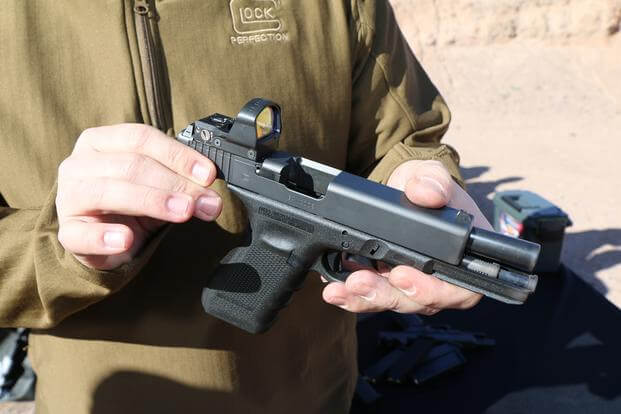LAS VEGAS -- Red-dot optics mounted on pistols are becoming so popular that some professional shooters see them replacing iron sights in the tactical environment.
Non-magnifying optics have long been the primary rifle sight for troops on the battlefield. Besides being accurate and durable, they are also faster than iron sights and perform better in low-light conditions.
Now the popularity of ultra-light red-dots -- such as Trijicon's Ruggedized Miniature Reflex, or RMR, sight -- has compelled pistol makers to introduce special lines of their handguns specifically designed for accepting red-dots.
Glock just unveiled its Modular Optic System at SHOT Show 2016. It's designed so shooters can install the red-dot of their choice with just a few tools. Smith & Wesson did the same at SHOT 2015 with the introduction of its M&P Competition Optics Ready Equipment, or C.O.R.E., pistols.
"Red dots on pistols are the future of handguns," said firearms instructor Matt Jacques.
At SHOT 2016, Jacques was showing off Raven Concealment's new Balor mount designed for an Aimpoint Micro T1 or H1 red-dot sight on a Glock with just a few simple tools.
Red-dots offer a single-sight plane, so the shooter doesn't have to worry about sight alignment as with traditional front and rear iron sights, Jacques said.
"It is literally put the red dot up there and all you have to worry about is your trigger press," said Jacques, a consultant for Raven Concealment.
Smith & Wesson's Tony Miele, however, doesn't think iron sights are going anywhere. The C.O.R.E. line of pistols was designed for competition shooters who need faster acquisition, he said.
David Teel of Glock agreed that iron sights will probably not disappear because they are the most basic sighting system that requires no power.
But as a law-enforcement firearms instructor and competitive shooter, Teel said he sees the benefit of red-dots on pistols for law enforcement work.
"The new generation coming into law enforcement doesn't have a good grasp of lining up iron sights, but they can play video games and are used to putting a red dot on a target in games such as 'Call of Duty,' " said Teel, who is Glock's law enforcement district manager for the state of Texas.
"A lot of people when they come into law enforcement, the first time they ever handle a firearm is at the academy. If I say 'put that red dot on that target and pull the trigger' -- it simplifies it. You are looking at one thing."
Competition shooters in the United States Practical Shooting Association have long used red-dots on their pistols. But many of these "race guns" are finely-tuned handguns equipped with special muzzle compensators.
Shooting red-dot-equipped pistols without a compensator will make it more difficult to get the red dot back on target during rapid fire shooting, some experts maintain.
Also, pistol shooters who are comfortable with traditional sights may find it harder to transition to the red dot, Jacques said.
"For people who have spent years using iron sights, there is a learning curve," he said.
-- Matthew Cox can be reached at matthew.cox@military.com.

























